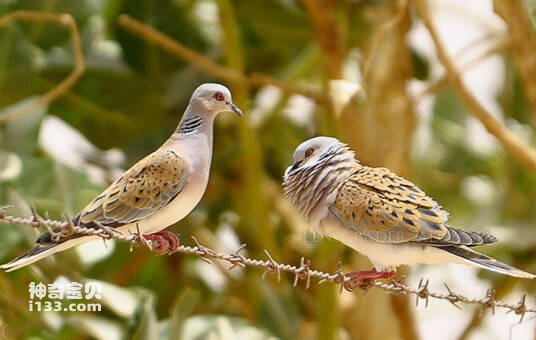Streptopelia turtur
IUCN
LCBasic Information
Scientific classification
- name:Streptopelia turtur
- Scientific Name:Streptopelia turtur,European Turtle-dove
- Outline:Landfowl
- Family:
Vital signs
- length:25-28cm
- Weight:120-150g
- lifetime:No textual research information is available
Feature
It's a slightly smaller pink-brown turtle dove
Distribution and Habitat
It is distributed in Afghanistan, Albania, Algeria, Andorra, Armenia, Austria, Azerbaijan, Bahrain, Belarus, Belgium, Bosnia and Herzegovina, Bulgaria, Burkina Faso, Cameroon, Cape Verde, Chad, China, Croatia, Cyprus, Czech Republic, Denmark, Egypt, Eritrea, Estonia, and Ethiopia Russia, Faroe Islands, Finland, France, Gabon, Gambia, Georgia, Germany, Ghana, Gibraltar, Greece, Guinea, Guinea-Bissau, Hungary, Iran (Islamic Republic of), Iraq, Ireland, Israel, Italy, Jordan, Kazakhstan, Kuwait, Kyrgyzstan, Latvia, Lebanon, Libya, Liechtenstein, Latvia Lithuania, Luxembourg, Macedonia, Mali, Malta, Mauritania, Moldova, Mongolia, Montenegro, Morocco, Netherlands, Niger, Nigeria, Oman, Palestine, Poland, Portugal, Qatar, Romania, Saudi Arabia, Senegal, Serbia, Sierra Leone, Slovakia, Slovenia, Somalia, South Sudan, Spain, Soviet Union Denmark, Sweden, Switzerland, Syrian Arab Republic, Tajikistan, Togo, Tunisia, Turkey, Turkmenistan, Ukraine, United Arab Emirates, United Kingdom, Uzbekistan
Appearance
Turtledove blue-gray forehead, crown to nape, light wine white on head and neck. There are several black patches on the lower part of the left and right sides of the neck, and the outer edge of each black patch is white, forming a black and white patch, which is extremely eye-catching in the pale neck. The upper back is light brown, with a light brown edge, and the lower back, waist, and tail cover are the same as the upper back, but darker brown. The shoulder and wings are covered with small cover, the inner middle cover and secondary fly feathers are dark brown, and the feather base has black brown triangular spots. The large coverts are pigeon gray, and the flying, primary and winglets are dark brown. Each feather has a brown outer margin except the alule. The tail is scalloped. Central tail feathers dark brown, with narrow white end spots; The rest of the tail feathers are black, also with white end spots, and from the inside out, the white end spots are becoming wider. The outermo
Details
The European turtledove (Streptopelia turtur) has four subspecies.

The turtle dove is a summer migratory bird. Spring moves in March-April; Autumn moves in September-October. Often alone or in pairs, rarely in groups. They roost and move in the trees most of the day, only going down to the ground to feed and drink. Foraging occurs in the morning after sunrise. It forages mainly on open ground, in glades, and along roadsides. After eating more in the canopy roost.
The turtle dove feeds mainly on the fruits and seeds of various plants. Also eat mulberry, corn, sesame, wheat and other crops and a small amount of animal food.
The breeding period of the turtle dove is from May to August. They often nest in pairs. They usually nest at the edge of forests. They also nest near farmland or even in small patches of jungle or bush near their houses. The nest is mostly placed in trees, and the height from the ground is mostly 2-6 meters. The nest is flat, mainly composed of dead branches, the structure is relatively loose and simple. The size of the nest is 12×13 cm inside diameter, 20×20 cm outside diameter, 3 cm deep, and 2 eggs are laid in each clutch. The egg is white in color, smooth without spots, and shiny. The size of the eggs is 29-35×22-25 mm, with an average of 32×23.7 mm. The male and female incubate the eggs in turn, and the incubation period is 13-14 days. Young birds are late sex. After hatching, it is raised by both male and female birds. After about 18 days of feeding, the young can leave the nest and fly.
It was listed in the List of Land Wild Animals under State Protection that are beneficial or have important economic and scientific research value (Item 228) issued by the State Forestry Administration of China on August 1, 2000.
Listed on the IUCN Red List of Threatened Species ver 3.1:2015-2019 - Vulnerable (VU).
Protect wild animals and eliminate wild meat.
Maintaining ecological balance is everyone's responsibility!








